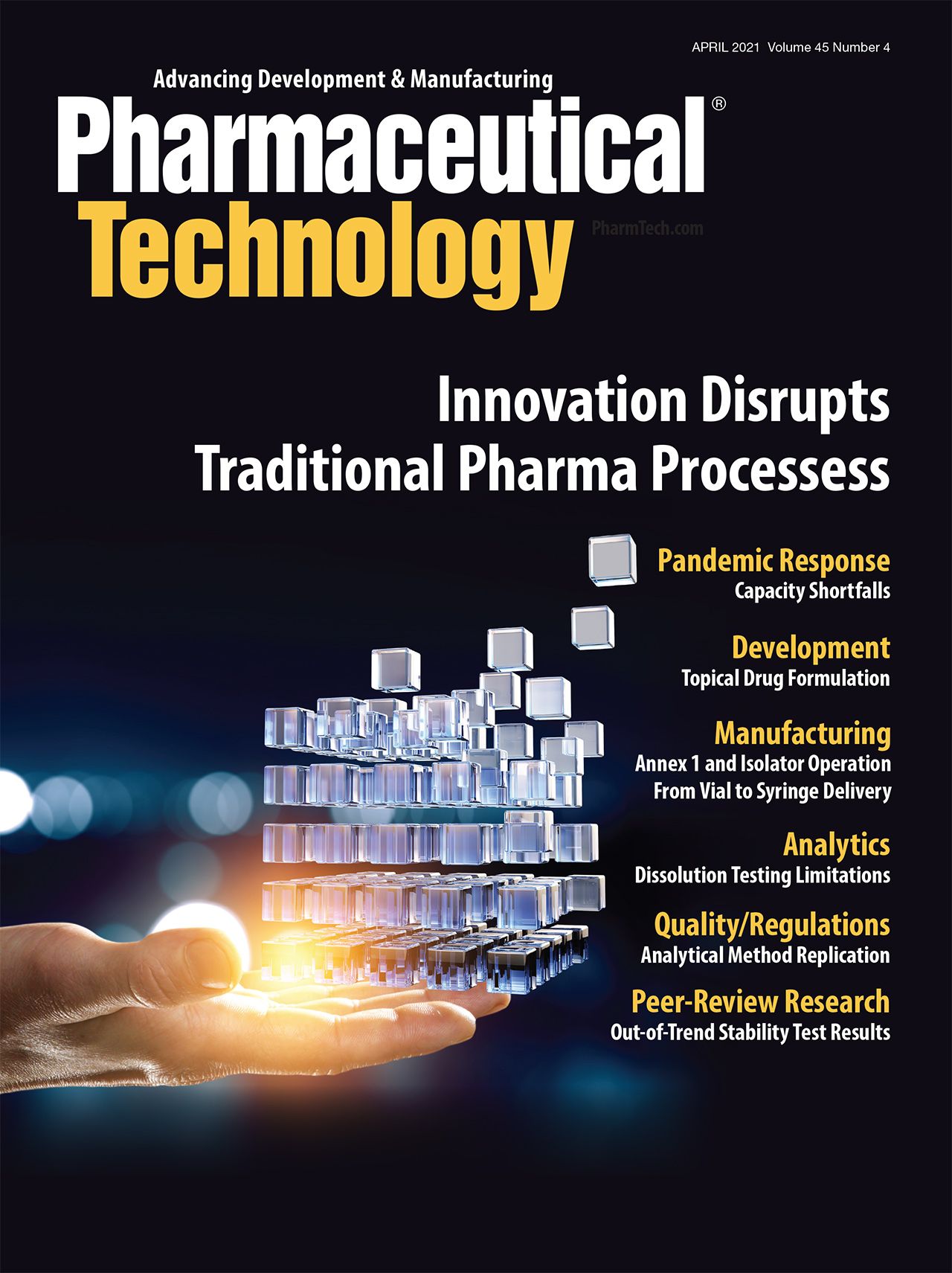Limitations and Advances in Dissolution Testing
Despite its importance in drug development, dissolution testing still has some limitations, but advances in automation and real-time monitoring are producing promising results.
LIDIIA - STOCK.ADOBE.COM

The importance and criticality of dissolution testing throughout the pharmaceutical drug development lifecycle is well-known and has been well-documented in literature. “Dissolution testing measures the extent and rate of solution formation from a dosage form, such as a tablet, capsule, or ointment,” says Sool Yeon Cho, department scientist, Nelson Laboratories. “The dissolution of a drug is important for its bioavailability and therapeutic effectiveness.”
Varying specifications
Dissolution rate specifications vary depending on the design of the dosage form. In 2018, FDA updated its guidance on recommendations for dissolution testing and specification criteria for immediate-release dosage forms that contain highly soluble compounds (1). However, not all drug products are covered by this guidance, which is applicable only to solid orally administered immediate-release drugs that are intended to be swallowed. Generally, when measuring the dissolution rate for an immediate-release dosage form, a single-time point specification is used—exceptions may occur when evaluating slow-dissolving drugs where two time points can be used—with samples taken between 30 and 45 minutes, and when approximately 75–80% of the active ingredient is dissolved (2).
However, for modified-release dosage forms, multiple time points are specified for characterization of the in-vitro dissolution rate—for delayed-release forms two time points are required and for extended-release at least three time points are required (3). For modified/extended-release dosage forms, dissolution testing should show the rate a solution is formed with the release of active ingredients over specified time intervals, explains Cho. Relevant guidance has been published to address the challenges of dissolution of modified or extended-release dosage forms (4,5).
When testing dissolution rates of solid-oral dosage form drug products, immediate-release and modified-release, standardized apparatus as described in the United States Pharmacopeia (USP) are employed (6). “USP General chapter <711> Dissolution includes four standardized apparatus: basket, paddle, reciprocating cylinder, and flow-through cell,” Cho notes. “Where specified in a monograph, USP dissolution tests are legal requirements.”
Yet, these standardized approaches are not without limitations, as have been previously reported in the literature (7–9). Issues relating to not only the equipment used in standardized approaches but also the analysts performing the tests can lead to dissolution profile variability.
Furthermore, for some dosage forms there are limited test methods described in the literature. As Speer et al. reported in 2019, for oromucosal film preparations with a modified release profile, despite there being a regulatory requirement to provide dissolution test data for this dosage form, there are no suitable recommendations of methods or established specifications available to follow (10). Therefore, when the test article may not respond to the standardized approaches and regulatory recommended methods, it may be necessary to employ new techniques or devices, Cho asserts.
Notable advances
“The most noticeable analytical method or technological advancement in recent years to aid with dissolution testing is automation,” confirms Cho. Although automated dissolution has been explored for some time, more
recent advancements have been seen in the use of computerized software that aids with the regulatory audit trail required, he adds. For Cho, full dissolution automation—sampling station and analysis—and a paperless dissolution workstation will be important trends in the near future.
Recent research by Chi et al. described an automatic method for dissolution testing with high-temporal resolution using high-speed capillary electrophoresis (HSCE) (11). In their work, the researchers’ proposed a system comprised of three components—a flow-through-cell for tablet dissolution, an automatic sequential injection with high-temporal resolution, and on-line separation/detection using HSCE. Validation of the methodology was performed according to FDA guidelines. Immediate and fixed-dose products were assessed by Chi et al. who found that with their fully integrated on-line automatic system it was possible to monitor dissolution with high-temporal resolution in real-time, which is promising particularly for fixed-dose combination drug products.
In other work, by Galata et al. in 2019, an artificial neural network (ANN) model was built to predict the dissolution profile of extended-release tablets (12). Using data collected by near-infrared and Raman spectroscopy, as well as the compression force measured by the tablet press as input data for the ANN model, the researchers were able to predict the in-vitro dissolution profile of extended-release tablets. The predictions of dissolution profiles were within the acceptance limit of the similarity factor, f2, and the authors concluded that with more work it could be possible to build models that consider more process parameters, allowing for a deeper understanding of product quality.
“Real-time release testing (RTRT) and how a multivariate model could create a surrogate for dissolution testing is certainly a trend for the industry,” Cho adds. “Since dissolution testing is not favored by industry—it is time consuming and does not always correspond to in-vivo dissolution—RTRT measurements, as a part of continuous manufacturing platforms are emerging to replace the traditional dissolution tests.”
References
1. FDA, Dissolution Testing and Acceptance Criteria for Immediate-Release Solid Oral Dosage Form Drug Products Containing High Solubility Drug Substances (August 2018).
2. M. Powell, “Specifications for Small-Molecule Drug Products,” PTI Webinar (Nov. 22, 2016).
3. F.R. Lourenço, et al., BJPS, 49 (2) 367–371 (2013).
4. FDA, Extended Release Oral Dosage Forms: Development, Evaluation, and Application of In Vitro/In Vivo Correlations, Guidance (September 1997).
5. EMA, Guideline on Quality of Oral Modified Release Products (London, UK, March 2014).
6. USP, General Chapter <711>, “Dissolution” USP 35–NF 30 (Rockville, MD, 2011).
7. S.A. Quershi and I.J. McGilveray, Eur. J. Pharm. Sci., 7 (3) 249–258 (1999).
8. J.L. Baxter, J. Kukura, and F.J. Muzzio, Int. J. Pharm., 292 (1–2) 17–28 (2005).
9. Z. Gao, et al., J. Pharm Sci., 96 (7) 1794–1801 (2007).
10. I. Speer, M. Preis, and J. Breitkreutz, AAPS PharmSciTech, 20 (1) 7 (2019).
11. Z. Chi, et al., Sci. Rep., 9 (Nov.) 17114 (2019).
12. D.L. Galata, et al., Pharmaceutics, 11 (8) 400 (2019).
About the Author
Felicity Thomas is the European editor for Pharmaceutical Technology Group.
Article Details
Pharmaceutical Technology
Vol. 45, No. 4
April 2021
Pages: 46, 64
Citation
When referring to this article, please cite it as F. Thomas, “Limitations and Advances in Dissolution Testing,” Pharmaceutical Technology 45 (4) 2021.

Drug Solutions Podcast: A Closer Look at mRNA in Oncology and Vaccines
April 30th 2024In this episode fo the Drug Solutions Podcast, etherna’s vice-president of Technology and Innovation, Stefaan De Koker, discusses the merits and challenges of using mRNA as the foundation for therapeutics in oncology as well as for vaccines.
Drug Solutions Podcast: Applying Appropriate Analytics to Drug Development
March 26th 2024In this episode of the Drug Solutions Podcast, Jan Bekker, Vice President of Business Development, Commercial and Technical Operations at BioCina, discusses the latest analytical tools and their applications in the drug development market.
INTERPHEX 2025: Use of Walk-In Chambers for Bio/Pharma Development and Manufacturing
April 2nd 2025Sitting down with the PharmTech Group at INTERPHEX 2025, Christopher Murphy, director of Global Business Development and Service Customer Support at Environmental Specialties, discusses the design and critical role of walk-in chambers in the bio/pharmaceutical industry.